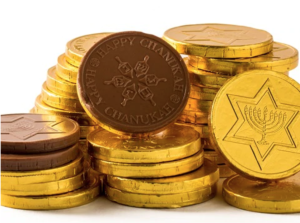 I don’t know about you, but my mental image of gold coins isn’t based on, say, my experience with the Roman aureus or Spanish doubloon, none of which I’ve ever seen. It’s based on those chocolate coins, or Hanukkah gelt, that come in the little mesh bags. So when my players find a cache of gold coins, that’s what I’m mentally giving out.
I don’t know about you, but my mental image of gold coins isn’t based on, say, my experience with the Roman aureus or Spanish doubloon, none of which I’ve ever seen. It’s based on those chocolate coins, or Hanukkah gelt, that come in the little mesh bags. So when my players find a cache of gold coins, that’s what I’m mentally giving out.
Those things are pretty massive for coins. Just how much would they weigh if solid gold?
Here are some 1 1/2 inch-diameter coins from Party City that weight .183 ounces each. It’s hard to nail down the mass of chocolate and I found varying estimates, but like many plant-derived things I think it weighs 60 pounds per cubic foot, the same as water – compared to 1200 pounds for gold. So gold is just a shade off 20 times heavier than milk chocolate.
That puts one solid gold coin, with the volume of a 1 1/2-inch chocolate gelt coin, at 3.66 ounces, or almost a quarter of a pound. Which is insanely heavy… the weight of more than 10 D&D gold coins, and more than twice the weight of Gary Gygax’s often-mocked 1e weight of 1/10 pound per coin.
At 1/10 the volume of a gelt coin, D&D gold coins are way smaller than I picture them. They’re much more accurate and close to the sizes of real Earth gold coins… but the coins of fantasy imagination are bigger than the little nickel-sized gold coins of history like the Spanish doubloon.
Here is my incontrovertible proof that D&D coins are bigger than nickels. No one could dispute this totally reasonable take.
See! Airtight reasoning, and not off the deep end at all!
Now let’s pretend that D&D coins are big, thick, 1 1/2-inch thick coins patterned after Hanukkah gelt. We’ll scale down to the relatively restrained Gygax 1/10 pound per coin. Get those bags of holding ready: a 60,000 coin trove would weigh 6,000 pounds. That’s a 10-cubic-foot pile, not really enough for a dragon bed, but enough to nearly fill up a mimic. That’s a bit more like the D&D treasure of my imagination.
There you go: in Pauls & Dragons, coins are big, delicious-looking, heavy hunks of gold like Hanukkah gelt. It costs 15 gp – one and a half pounds of gold – for a 3-pound longsword. Kind of a crazy economy – but at least the coins are delicious.







Fun article. I think I like coins about the size of Hanukkah gelt, but maybe thinner so they’re lighter. Maybe only an inch in diameter. Three pounds of gold to pay for a long sword is more inflation than I can stomach…
Clearly D&D coins are made from alchemical gold and silver, the more durable, lightweight variety used to produce magic weapons.
Think of it more like “Pieces of eight!”. A single ‘gold piece’ in D&D is a small fraction of the actual coin.
Also consider debasing. Those coins are very much not ’24-karat’ and could be simply plated bronze. Test ’em with your teeth, people!